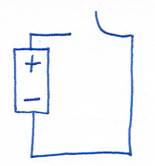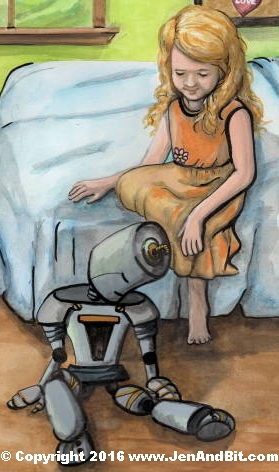Video Tutorials
Video Tutorial 1: Overview
of the Fetch operation of a fully functional simple digital computer, the "SIMCO".
Video Tutorial 2 (first half): Tracing the operation
of the "simco" digital computer, logic gate by logic gate, as it follows a computer program to sound an alarm when a window is open.
Video Tutorial 2 (second half): Tracing the operation
of the "simco" digital computer, logic gate by logic gate, as it follows a computer program to sound an alarm when a window is open.
Video Tutorial 2 (End of Part 2): Tracing the operation
of the "simco" digital computer, logic gate by logic gate, as it follows a computer program to sound an alarm when a window is open.
Articles
Programming the SIMCO in Assembly Language
What Is A Computer? Computer Programming, The Purpose of All Computers
Building Simple Machines That Make Decisions
Getting Started Using Programmable Logic Devices
|
Building Simple Machines That Make Decisions
What is a decision? A decision is a choice between 2 or more possibilities. For example, if you are lost while driving down a one way road and come to a fork in the road, you must make a decision. You must decide whether to turn right or left. The simplest decision you can make is one where a MINIMUM of 2 possible choices are involved. While driving down the one way road, until you come to the fork in the road, you have no choice in your behavior, you must continue driving forward.
All decisions take the form of an “IF THEN” statement, also called a “conditional” or “propositional” statement. For example, you can decide “IF I come to a fork in the road, THEN I will turn left”. In order to make a decision, one of 2 possibilities must be satisfied. In the above example, the two possibilities are:
- 1) I have come to a fork in the road.
- and 2) I have not come to a fork in the road.
The simplest “If Then” decision making machine you can build is simply an electrical switch.
An electrical switch is nothing more than a way to open and close a circuit. A circuit is a piece of wire connecting two ends of a battery together. The loop formed by connecting the wire to the ends of the battery is called a closed circuit.
If one of the ends of the wire is removed from the battery, the circuit is said to be opened.
 |
 |
(A closed circuit)
|
(An open circuit) |
If a light bulb is connected to a closed circuit, the electrical energy from the battery will travel from the battery, through the wire, and through the bulb, lighting the bulb.
If you disconnect one of the ends of the wire from the battery, the circuit is said to be open. Electrical energy will not travel through an open circuit, and the light bulb will turn off.
 |
 |
(A closed circuit lighting a light bulb)
|
(An open circuit. The light bulb is off.)
|
A switch is nothing more than a convenient way to open and close a circuit.
Literally, a switch itself is a piece of wire. When you open the switch, the circuit the switch is connected to is opened. Electrical energy will not travel through an open circuit, and the light bulb will turn off.

(A circuit is opened by opening a switch.
This turns off the bulb.)
A switch is a representation of the decision, IF the switch is closed, THEN light the bulb.
Like all decisions, the decision to light the bulb involves more than one possibility. In this case, there are two, either the switch is closed OR the switch is open.
The statement, “I have come to a fork in the road”, is also called a PROPOSITION.
What is a proposition?
A proposition is a statement that can be either true or false.
The proposition “I have come to a fork in the road”, like ALL propositions, has 2 possibilities…It is either true OR it is false.
Because a proposition always has a minimum of two possibilities, either true or false, any proposition can be represented by a SWITCH!
The scientist Claude Shannon was the first person in the world to recognize that propositions are equivalent to electrical switches.
With this insight, in his 1938 paper, “A Symbolic Analysis of Relay Switching Circuits”, Claude Shannon showed how the branch of mathematics called Propositional Logic could be completely represented by electrical switches. (This paper, and the paper by Alan Turing referenced above, are the two founding papers for ALL of modern computer engineering and computer science.)
On page 11 of his paper, Shannon defines a closed loop circuit as representing a TRUE proposition.
<Picture Here> } “I have come to a fork in the road” = TRUE
He then defines an open circuit as representing a false proposition.
<Picture Here> } “I have come to a fork in the road” = FALSE
Propositional Logic is the study of the logical relationships between 2 or more propositions. In his 1858 book titled “The Laws of Thought”, George Boole showed that there are only 3 possible relationships between any two propositions, from which propositional statements of greater and greater complexity can be derived.
These are the AND relationship, the OR relationship, and the NOT relationship.
Building your second decision making machine, a burglar alarm.
Imagine you have accepted a job as a night watchman for a museum. The museum has one window. Your boss leaves you with the following instructions:
“IF the window opens THEN sound the alarm.
These instructions are in the form of a decision, and this decision, like ALL decisions, can be represented by a switch. Below is a picture of a switch like the one drawn above, only this switch is permanently kept open as long as the window is closed. When the window is opened, a spring beneath the switch pushes the switch closed, closing the electrical circuit and causing electrical energy to travel through the bell, ringing the alarm.
 |
 |
|
IF the window is open
THEN sound the alarm.
|
Machines that make multiple decisions at the same time, AND and OR circuits
Memory square 2 in the Garage Door Opener Circuit actually has two IF THEN statements.
The instruction in memory square 2 is:
IF the Garage Door is open
AND IF The Close Button is pressed
THEN Turn on the electric motor that closes the garage door (the down motor)
A machine that must make more than one decision at the same time can be created by connecting switches in series.
Relays: “Hands Free” decision making machines. (The first “automatons”?)
 |
If you wind a piece of wire into a coil and connect the ends of the wire to a battery, a magnetic field will be created around the coil. The more loops there are in the coil, the stronger the magnetic field will be.
A coil connected to a battery is called an Electro Magnet. |
 |
 |
| If you place a metal hinge connected to a spring next to an electromagnet, the magnetic field will pull the hinge towards the electromagnet |
If you OPEN the electromagnet circuit, electrical energy will stop traveling through the coil, and the magnetic field will be destroyed. With the magnetic field gone, the spring will pull the metal hinge back into place. |
 |
 |
| The metal hinge itself can be thought of as a switch, which can be opened or closed by the presence of the magnetic field. In this illustration, the magnetic field pulls the switch closed, lighting the bulb. |
When the magnetic field is gone, the spring pulls the switch open, and the bulb turns off. |
A metal switch, held in one position by a spring, and in another position by a magnetic field, is called a RELAY. All relays basically consist of a two separate circuits, a coil circuit to generate a magnetic field and a metal switch circuit.
Below is a relay that turns the bulb OFF when the magnetic field is present, and ON when the magnetic field is gone.
|

Jen has a Bot.
Bit the Bot.
If Bit is On, He Can Do (and say) A Lot!
Coming Soon...
Meet Bit the Bot, a talking robot that convinces us of our own, true, spiritual nature...
and who opens minds to be receptive to the Gospel message of salvation through Christ Jesus.
Talk to Bit the Bot soon about his adventures with Jen and Ben at www.JenAndBit.com
|